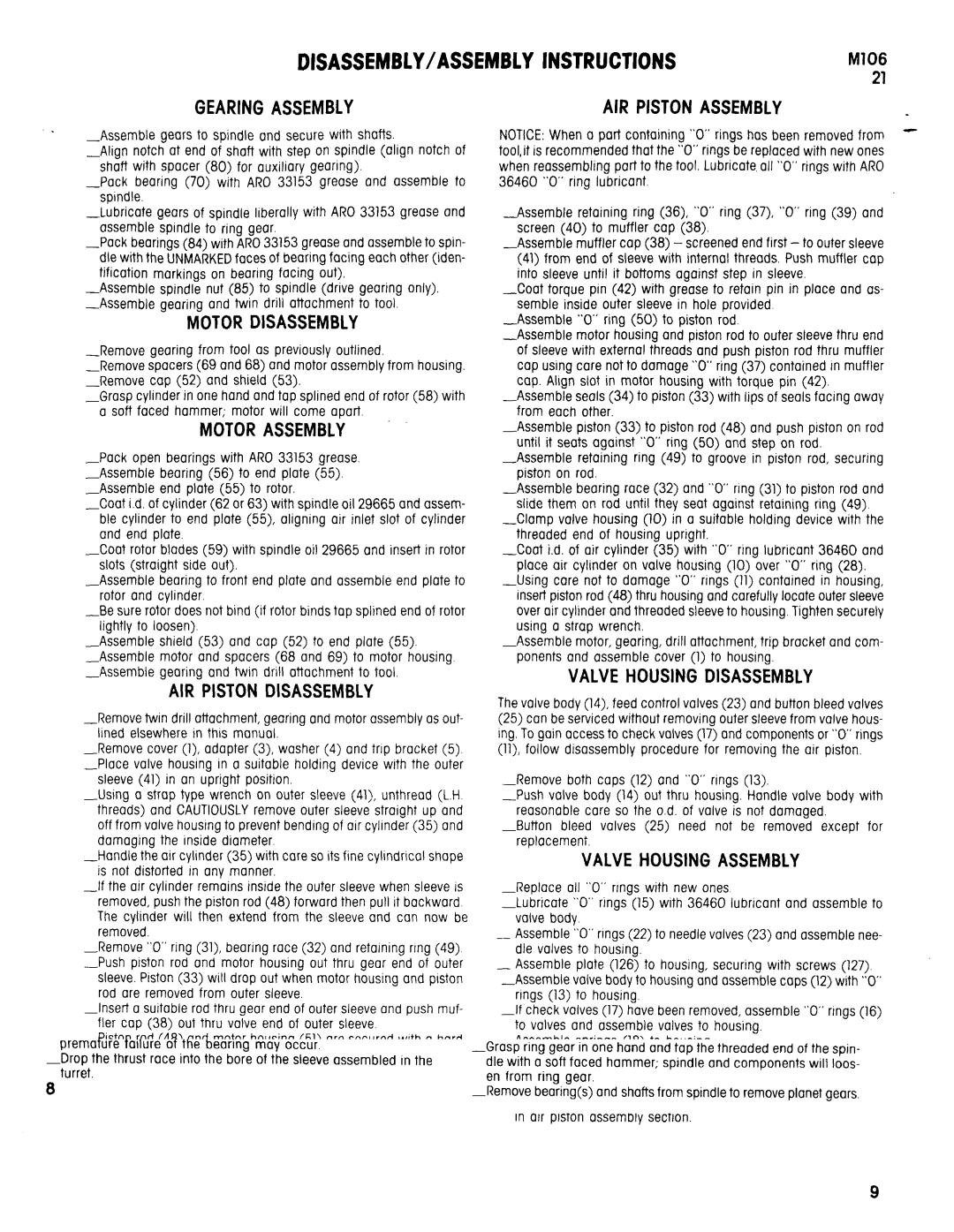GEARING ASSEMBLY
-Assemble gears to spindle and secure with shafts.
-Align notch at end of shaft with step on spindle (align notch of shaft with spacer (80) for auxiliary gearing).
-Pack bearing (70) with ARO 33153 grease and assemble to spindle.
-Lubricate gears of spindle liberally with ARO33153 grease and assemble spindle to ring gear.
-Pack bearings (84) with ARO33153greaseand assembleto spin- dle with the UNMARKEDfaces of bearing facing each other (iden- tification markings on bearing facing out).
-Assemble spindle nut (85) to spindle (drive gearing only). -Assemble gearing and twin drill attachment to tool.
MOTOR DISASSEMBLY
-Remove gearing from tool as previously outlined.
-Remove spacers (69 and 68) and motor assemblyfrom housing. -Remove cap (52) and shield (53).
-Grasp cylinder in one hand and tap splined end of rotor (58) with a soft faced hammer; motor will come apart
MOTOR ASSEMBLY
-Pack open bearings with ARO33153 grease. -Assemble bearing (56) to end plate (55). -Assemble end plate (55) to rotor.
-Coat i.d. of cylinder (62 or 63) with spindle oil 29665 and assem- ble cylinder to end plate (55), aligning air inlet slot of cylinder and end plate.
-Coat rotor blades (59) with spindle oil 29665 and insert in rotor slots (straight side out).
-Assemble bearing to front end plate and assemble end plate to rotor and cylinder.
-Be sure rotor does not bind (if rotor binds tap splined end of rotor lightly to loosen).
-Assemble shield (53) and cap (52) to end plate (55).
-Assemble motor and spacers (68 and 69) to motor housing -Assemble gearing and twin drill attachment to tool.
AIR PISTON DISASSEMBLY
-Remove twin drill attachment,gearing and motorassemblyas out- lined elsewhere in this manual.
-Remove cover (1), adapter (3), washer (4) and trip bracket (5) -Place valve housing in a suitable holding device with the outer
sleeve (41) in an upright position.
-Using a strop type wrench on outer sleeve (41), unthread (L.H threads) and CAUTIOUSLYremove outer sleeve straight up and off from valve houslng to prevent bending of air cylinder (35) and damaging the inside diameter
-Handle the air cylinder (35) with care so its fine cylindrical shape is not distorted in any manner.
-If the air cylinder remains inside the outer sleeve when sleeve IS removed,push the piston rod (48) forward then pull it backward The cylinder will then extend from the sleeve and can now be removed.
-Remove “0”ring (31), bearing race (32) and retaining ring (49) -Push piston rod and motor housing out thru gear end of outer sleeve.Piston (33) will drop out when motor housing and piston
rod are removed from outer sleeve.
-Inserta suitable rod thru gear end of outer sleeve and push muf- fler cop (38) out thru valve end of outer sleeve
-Piston rod (48) and motor housing (51) are secured with a hard drying thread adhesive.If it should become necessaryto separate these two parts, heat the threaded area lightly to soften the adhe- sive and unthread the rod from the housing - R.H.threads.
AIR PISTON ASSEMBLY
NOTICE:When a part containing “0”rings has been removed from tool, itis recommendedthat the “0”rings be replaced with new ones when reassembling part to the tool. Lubricate all “0”rings with ARO 36460 “0” ring lubricant.
-Assemble retaining ring (36), “0”ring (37), “0”ring (39) and screen (40) to muffler cap (38).
-Assemble muffler cap (38) -screened end first-to outer sleeve
(41)from end of sleeve with internal threads. Push muffler cop into sleeve until it bottoms against step in sleeve.
-Coat torque pin (42) with grease to retain pin in place and as- semble inside outer sleeve in hole provided
-Assemble “0” ring (50) to piston rod
-Assemble motor housing and piston rod to outer sleeve thru end of sleeve with external threads and push piston rod thru muffler cop using core not to damage “0”ring (37) contained in muffler cap. Align slot in motor housing with torque pin (42).
-Assemble seals (34) to piston (33) with lips of seals facing away from each other.
-Assemble piston (33) to piston rod (48) and push piston on rod until it seats against “0” ring (50) and step on rod.
-Assemble retaining ring (49) to groove in piston rod, securing piston on rod.
-Assemble bearing race (32) and “0”ring (31) to piston rod and slide them on rod until they seat against retaining ring (49)
-Clamp valve housing (10) in a suitable holding device with the threaded end of housing upright.
-Coat i.d. of air cylinder (35) with “0”ring lubricant 36460 and place air cylinder on valve housing (10) over “0” ring (28).
-Using care not to damage “0”rings (11)contained in housing, insertpistonrod (48) thru housingand carefully locate outersleeve over air cylinder and threaded sleeveto housing. Tighten securely using a strap wrench.
-Assemble motor, gearing, drill attachment,trip bracket and com- ponents and assemble cover (1) to housing.
VALVE HOUSING DISASSEMBLY
Thevalve body (14),feed control valves (23) and button bleed valves
(25)can be serviced without removing outer sleevefrom valve hous- ing. To gain accessto check valves (17)and componentsor “0”rings (11),follow disassembly procedure for removing the air piston.
-Remove both caps (12) and “0”rings (13).
-Push valve body (14) out thru housing. Handle valve body with reasonable care so the o.d. of valve is not damaged.
-Button bleed valves (25) need not be removed except for replacement.
VALVE HOUSING ASSEMBLY
-Replace all “0” rings with new ones
-Lubricate “0” rings (15) with 36460 lubricant and assemble to valve body.
- Assemble“0”rings (22) to needlevalves (23) and assemblenee- dle valves to housing.
Assemble plate (126) to housing, securing with screws (127) IAssemble valve bodyto housing and assemblecaps (12)with “0”
rings (13) to housing.
-If check valves (17)have been removed,assemble “0”rings (16) to valves and assemble valves to housing.
-Assemble springs (18) to housing.
-Assemble “0” ring (20) to screw plug (21) and assemble to housing
-Assemble screw plug (19) to housing
-Assemble outer sleeve and components to housing as described in air piston assembly section.

